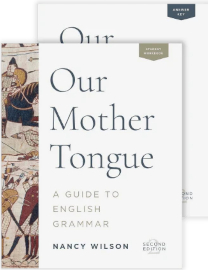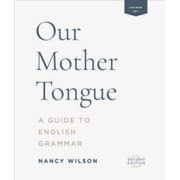Our Mother Tongue teaches the eight parts of speech from a Christian worldview to students in grades seven and above. It’s ideal for those pursuing a classical education but is not limited to that audience.
I say this because the textbook has the structure and orderliness of many classical (as well as many traditional) grammar resources, ensuring thorough coverage, including sentence diagramming. It also frequently discusses connections to Latin. For instance, on page 12 it says, “A noun of direct address is called the vocative, which comes from the Latin word voco—“I call.” In addition, "Historia” sidebars draw heavily from Charles Dickens’ A Child’s History of England to discuss historical events that influenced the development of language.
As author Nancy Wilson explains in the introduction, she has relied on time-tested grammar instruction, examples, and exercises from resources such as the Bible and nineteenth-century grammar books—and that she has “merely researched, arranged, collected, and organized data.” Even so, the course does not feel archaic as do some that use material from older resources. For instance, most students will enjoy the inclusion of sentences to diagram such as, “The hobbits huddled around the fire, and they could see orcs in the distance” (p. 140). And some sentences draw on historical content, such as this one on page 49 that asks students to fill in a suitable coordinating conjunction: “Hannibal, Caesar, ___ Napoleon were great generals.”
The course consists of the textbook and an answer key, both printed in black and white. The textbook has six units. The first four units each have six or more lessons while the last two units have three and two lessons, respectively.
Lessons are presented in a traditional fashion, with instruction, examples, and exercises. Some lessons also have a review exercise and/or review questions. The first four units conclude with a cumulative review of the unit’s lessons. (The last two units are too short for a review.) Sentence diagrams are introduced in Lesson 12 and are used through the rest of the course's 49 lessons.
Students should be able to work through Our Mother Tongue independently, although some would benefit from a teacher presenting the lessons and working through the examples.
While some exercises should be completed within the textbook, some, such as sentence diagrams, will need to be done elsewhere.
An appendix includes a brief guide to punctuation and text formatting, but this course does not try to cover all aspects of grammar. Students in junior and senior high generally need more work on punctuation, capitalization, and usage, as well as the entire realm of composition skills.
The 60-page answer key has answers for all exercises and reviews in the textbook, including sentence diagrams.
Summary
Our Mother Tongue is a well-written and efficient resource for reviewing (or teaching for the first time) the eight parts of speech and their functions within sentences, and the content is written at a level that should appeal to older students.











